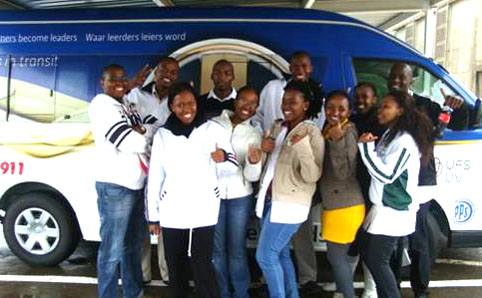|

|
|
Senior medical students who make use of the shuttle services are standing next to the mini-bus.
|
On Friday, 30 September 2011, our university will officially launch its shuttle service for medical students. This function will take place from 12:00 to 13:00 at the Faculty of Health Sciences’ CJC Nel Reception Venue in the Francois Retief Building on our Bloemfontein Campus.
Two years ago. Dr Scarpa Schoeman began working at Internal Medicine at our Faculty of Health Sciences. Early on, he identified the transport problems of fourth- and fifth-year medical students (Phase-3 students) in the English class.
There are 65 Phase-3 students in the English class who are currently struggling with transport and who are part of this project. About 90% of them are bursary students at the university who, according to Schoeman, are consequently also struggling with finances. These students used public transport like taxis to move between hospital rounds and classes in the past. On average, it would cost them up to R4 000 per year for these daily travels between the UFS and the various training hospitals.
By the end of March 2011, NetCare had donated two mini-busses to the UFS and since 11 April, the shuttle services were available to medical students. Prof. Gert van Zyl (Dean of our Faculty of Health Sciences), Mr Mickey Gordon (Head: Marketing, Institutional Advancement and Sport) and the Rector, Prof. Jonathan Jansen, negotiated with NetCare. Gordon was also responsible for the branding of the busses. PPS and Pfizer are both sponsors who contributed to this.
This project is managed by Dr Schoeman, assisted by Mrs Anne-Marie Nel, who handles the administration as the Phase-3 secretary.
“It is important for us from the project management that students won’t see this as another taxi, but as a shuttle service of the university. Any senior medical student may make use of it, but it is mainly the under-privileged student from the English class who makes use of it.”
The two Quantum mini-busses do the circuit according to fixed schedules each day. The route starts at the Francois Retief Building on our Bloemfontein Campus and then travels to the National Hospital, the Free State Psychiatric Complex (Oranje), Pelonomi, 3 Military Hospital (at Tempe) and then back again to Universitas Hospital.